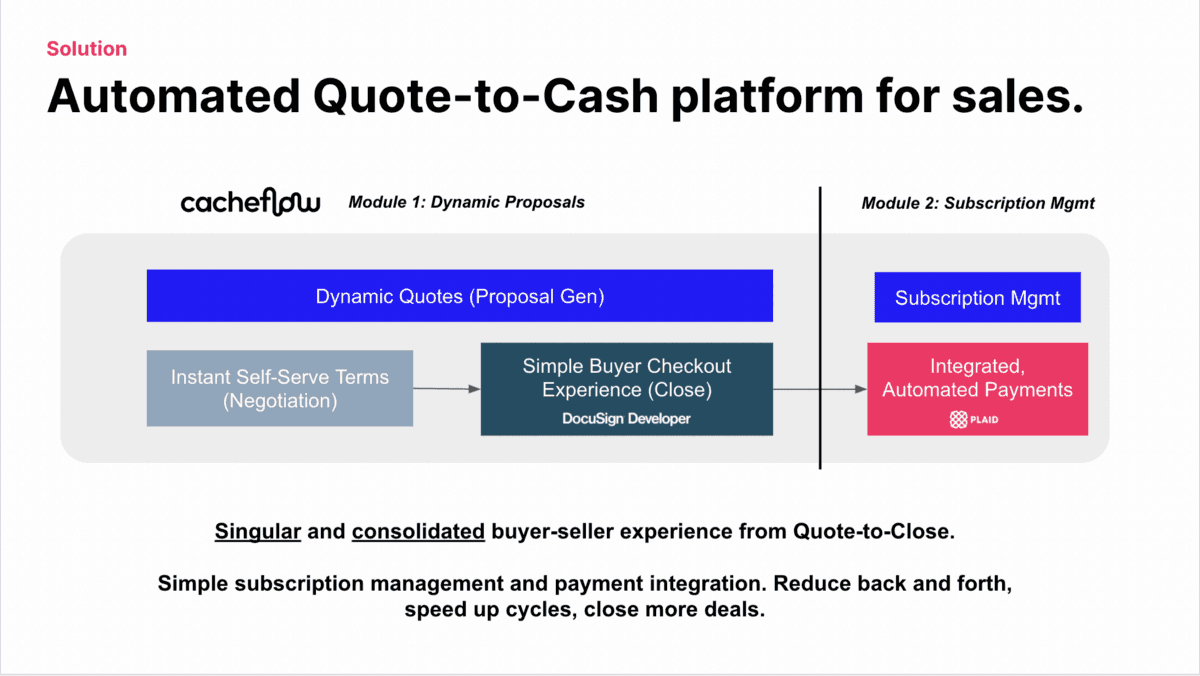BLOG

Date
Apr 1, 2022
Author
Jeremy Vo
Industry at Glance
The world of SaaS has risen dramatically in the last five years, currently growing by 18% YoY. Virtually all organizations leverage software in some capacity — whether it is for human resources, customer relationship management, project management or sales. Zoning in on the sales org of companies, there is an entire portfolio of software tools to leverage. In fact, Intercom estimates that the optimal sales tech stack includes 55 distinct tools. Think about tools like Hubspot, DocuSign, DealHub, ChargeBee, and Google Docs, all of which are ingrained into the fabric and operations of companies. With increasing fragmentation of sales tools, many of which are point solutions, inefficiency enters the equation at various points in the sales cycle. Sales reps are forced to juggle between an overwhelming cluster of tools, while simultaneously catering to unique customer needs.
About Cacheflow
Enter Cacheflow (CF), which radically simplifies the buying experience so that SaaS companies can sell more, faster. Their customers have an automated experience that can be completed in a few minutes and financing is embedded in the experience to optimize cash flow for both parties. Cacheflow’s founder and CEO, Sarika Garg, noted that “the sales process and the buying process are both broken today. While working at the leading CRM company and the leading procurement company, my co-founder, Brian Zotter and I realized — that buying and selling are two sides of the same coin. The fastest path to closing a deal is by helping the buyer make the decision faster. We are excited to build the first company that’s thinking about buying and selling SaaS as one integrated offering” (Source).
Timing and Stage
CF was first introduced to the LeapMotiv (LM) team through one of their investors. At this stage, CF’s team was a CEO, CTO, a handful of engineers, $6M in funding, and an early prototype. The venture was in rapid development mode and coveted a general idea of its customer segment. However, they needed to clarify the exact problem, use cases, and target segments that made the most sense to market with. With fresh financing, CF was eager to ramp up go-to-market efforts and prove early customer traction. Having validated over 20 ventures, LM’s offering aligned seamlessly. Through a structured approach, we test different channels and messaging to identify a target segment that resonates with the problem. Once the problem is validated, we enter solution validation where we get this curated pipeline signed up for pilots and ultimately converted to paid customers.
Phase 1: Problem Validation
In December 2021, the problem validation phase of our engagement kicked off. The first step? Syncing with CF founders to jointly identify and formulate a testable hypothesis. This onboarding stage is instrumental for a few reasons — to collect data points and assumptions, gain industry insight, and most importantly establish a meaningful relationship with the CF team to understand their mission, vision, and objectives. Through a methodical brief coupled with an initial deep-dive call, LM and CF agreed on the current — and iterative — business hypothesis: B2B SaaS companies (Series A, B, C, D) experience friction when closing sales deals with smaller-sized customers because payment options for customers are rigid/limited and the closing steps are manual. To validate this claim, we ran cold outreach with VC-funded (series A & B) SaaS companies and walked them through guided interviews.
In the first campaign, we tested multiple channels, messaging, and customer segments, ultimately resulting in a 35% validation rate. This means that out of 17 prospects we met with, 6 validated our initial hypothesis by acknowledging a pain point and believing it was worth solving. Harnessing these learnings, we ran two more campaigns with a revised positioning and target segment. Generally, follow-on campaigns accrue more traction because we garner a deeper understanding of the customer. Upon modification, the two value propositions that generated the highest response rate were as follows: “I am trying to help Heads of Sales close more deals, faster by automating the Quote-to-Cash workflow for their reps,” and “I am trying to help sales teams increase velocity by shortening the Proposal-to-Close timeframe.” In this campaign, 85% of prospects validated the hypothesis, more than 2x the original campaign. The momentum was building up, and we were beginning to make inroads into customers that had a strong expression of the problem to be solved.
Given the fast-paced approach to our work, we connect frequently with the client for weekly check-ins and Slack communications. In these calls, the biggest takeaways for Sarika was seeing video anecdotes of prospect customers validating the problem at hand. The CEO listens to all customer calls and showcases the most appropriate ones to her engineering team. Through this process, Sarika was able to learn at the same fidelity and velocity as us. We find that the most successful founders watch each individual call and care deeply about the problem over purely the solution. Ultimately, we represent the voice of a CF customer and have even demonstrated these findings at executive meetings.

Phase 2: Solution Validation
At this stage, LM had run calls with over 50 B2B sales leaders. We identified their pain points, current operations/processes, and uncovered what they care about most. With this ammunition, our current objective was to show a high-level solution to the most attentive segment and gauge their thoughts on the approach. We reconnected with our pipeline to provide an update on CF, an aggregation of all our learnings, and a recap of our previous call. Further, we walked them through two fidelities of the solution — both a system diagram and a demo-ready prototype. The response generated from different fidelities enabled our team to validate the solution on a strategic and tactical basis. In three months, we received five verbal pilot agreements, one LOI, and valuable feedback to inform product requirements for MVP.

The entire puzzle was beginning to formulate - a visible pain point for sales leaders, and a positive response to CF as a viable solution. As this phase progressed, we stayed in constant communication with the CF team through weekly updates on our learnings, discoveries, and results. We were no never treated as outsourced manpower, but rather an extension of their product/sales team. At LeapMotiv, we feel the most comfortable operating as part of the team instead of as a separate entity.
Phase 3: Customer Acquisition
LM efforts are now focused on acquiring 10 paid customers, therefore demonstrating proven traction for Series A fundraising. We have collected ample data to make informed and productive decisions, although customer feedback and product iteration will continue. So will the “great energy and great pace,” as reflected by Sarika.
